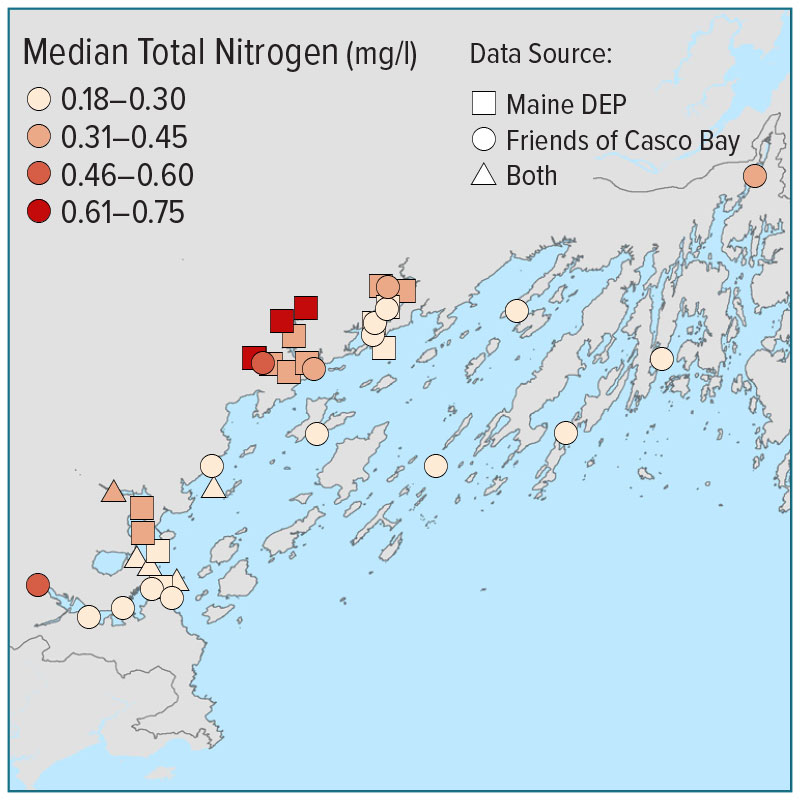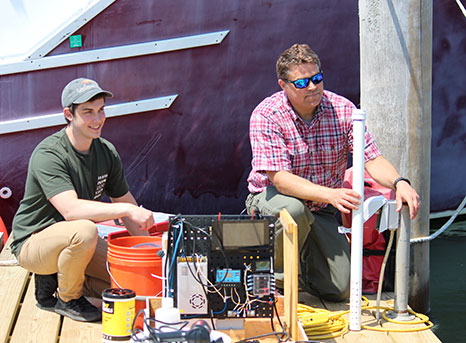Nutrient Pollution Puts Bay Water Quality at Risk
Community Efforts to Protect Water Quality and the Bay’s Natural Resilience Have Prevented Widespread Impacts
WHY IT MATTERS
Nutrients like nitrogen and phosphorus are essential to all life, but high levels in aquatic ecosystems can sometimes fertilize excessive growth of phytoplankton and other algae. The consequences can be profound: harmful algae blooms, low dissolved oxygen, disappearance of eelgrass and kelp, loss of marine habitat, declines in marine harvests, coastal acidification, even fish kills. While phosphorus is often the nutrient of primary concern in Maine lakes, nitrogen is more likely to be a primary concern in Casco Bay.
Nutrients entering Casco Bay come predominately from three sources: wastewater treatment facilities, direct atmospheric deposition, and runoff (including stormwater, combined sewer overflows, and river discharges). Recent data provide good estimates of atmospheric, wastewater, and tributary loads, but the size of the runoff component is not as well understood.
Data from the 1990s and early 2000s indicated that Casco Bay’s overall nitrogen load was low compared to most other large estuaries in the northeastern U.S. However, the nitrogen loading is concentrated near Portland, raising local concerns.
- combined sewer overflow (CSO),
- direct runoff from urban areas, and
- septic systems.
STATUS & TRENDS
Documented Nitrogen Loads from Three Sources
Tributaries
Wastewater
Atmospheric Deposition
*Total Nitrogen (TN) includes the sum of nitrogen from ammonium (NH4+), nitrate (NO3-), nitrite (NO2-), and organic nitrogen in water. Source: University of Maine, Maine Department of Environmental Protection (DEP), and National Atmospheric Deposition Program. CBEP estimates of annual loads based on most recent available data.
Total Nitrogen Regularly Exceeds Water Quality Thresholds

Elevated nitrogen levels have been observed regularly in portions of Casco Bay, especially in the tidal estuaries of the Royal, Presumpscot and Fore Rivers. Graph: Data collected from 2015 through 2019 by Friends of Casco Bay and Maine Department of Environmental Protection show that levels above DEP’s advisory thresholds (0.32 mg/l TN to protect eelgrass; 0.45 mg/l TN to reduce risk of low dissolved oxygen) occurred in most areas. Map: Typical nitrogen concentrations are higher in Casco Bay’s restricted bays and tidal tributaries than in the Bay’s open waters, where tidal currents facilitate waters mixing.
Long-Term Decline in Atmospheric Deposition of Nitrogen

Nitrogen Decreasing Over Time
successes & challenges
- Portland Water District updated the aeration system at the East End Wastewater Treatment Facility in 2016 and 2017. Summer discharges of nitrogen to the Bay have dropped by nearly three quarters.
- Atmospheric deposition of nitrogen has been declining for several decades, likely as a result of adoption of emission control technologies on power plants and automobiles; improved automobile fuel efficiency; and reduced reliance on coal for electrical generation. Further reductions in nitrogen deposition are likely with increasing adoption of electric vehicles and reduction in fossil fuel use.
- Over the last five years, understanding of nitrogen in Casco Bay has improved thanks to focused efforts by Maine’s Department of Environmental Protection, the University of Maine, Friends of Casco Bay, and Casco Bay Estuary Partnership. More research is needed to characterize terrestrial sources, understand how water movement affects nutrients in the Bay, and learn how recycling of nutrients from the Bay’s sediments affects water quality.
- Controlling nitrogen delivery in runoff from urban areas can be difficult. Most stormwater control structures are more effective at trapping phosphorus than nitrogen. “Green infrastructure,” which relies on living organisms for nitrogen control, can be more effective than traditional structures, but adoption has been slow.
View a PDF version of this page that can be downloaded and printed.
View references, further reading, and a summary of methods and data sources.
STATE OF CASCO BAY
Drivers & Stressors
What’s Affecting the Bay?
Human Connections
What’s Being Done?
If you would like to receive a printed State of Casco Bay report, send an email request to cbep@maine.edu.
This document has been funded by the U.S. Environmental Protection Agency under Cooperative Agreements #CE00A00348-0 and #CE00A00662-0 with the University of Southern Maine.
Suggested citation: Casco Bay Estuary Partnership. State of Casco Bay, 6th Edition (2021).
Photo at top of page: Jerry Monkman, Ecophotography.com